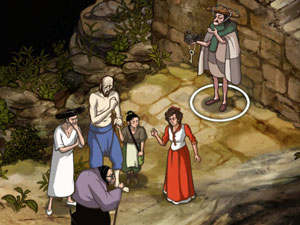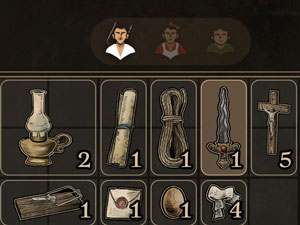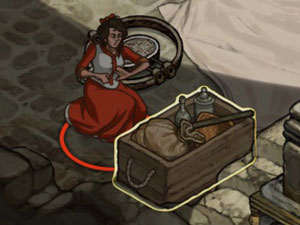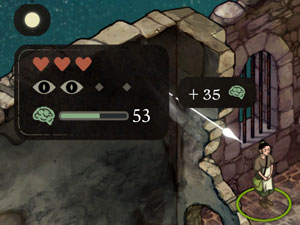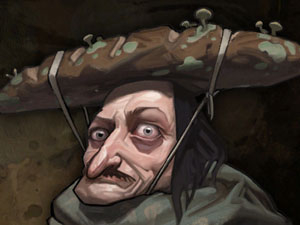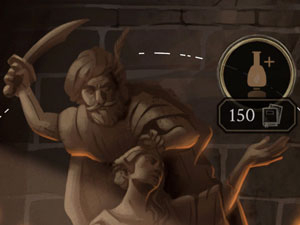The Stone of Madness
 by Aethyna
Apr 7, 2025 |
1
Votes |
25
Played |
0
Reviews
by Aethyna
Apr 7, 2025 |
1
Votes |
25
Played |
0
Reviews
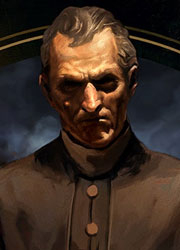 9
rate
Join a group of highly skilled inmates determined to escape from a mysterious monastery - only to find themselves entangled in a dangerous job that could be their last. Outsmart relentless guards and deadly animas, and manage your team’s mental state and fears. Above all else—stay hidden, stay sharp, and don’t get caught!
Play Now
Similar Games
Played
9
rate
Join a group of highly skilled inmates determined to escape from a mysterious monastery - only to find themselves entangled in a dangerous job that could be their last. Outsmart relentless guards and deadly animas, and manage your team’s mental state and fears. Above all else—stay hidden, stay sharp, and don’t get caught!
Play Now
Similar Games
Played
People Also Played







Summary
Set in 18th century Spain, The Stone of Madness is a real-time tactical stealth game set in a mysterious monastery consisting a madhouse and an inquisitorial prison. Join a group of multi-skilled inmates who are determined to escape from the hellhole, but they are roped into a job that, if they are not careful, might just be their last. Outwit guards and animas, use various abilities to accomplish your goals, manage your team’s mental states and fears, and most of all, don’t get caught!
Plotline
A priest, Father Alfredo Martin, was sent to a lost monastery in the Pyrenees to expose the corruption there, but he was forcefully imprisoned at the part of the monastery that was dedicated to the care of the insane and sick under the pretense of insanity when he got too close to the truth.
Thankfully, he was not alone.
He and his group of companions are planning a daring escape and a secret room that he was lucky enough to find in his cell while trying to dig his way out served as their base of operations, where they plan and strategize for the next day. Can they free themselves from the physical and mental shackles placed upon them by the monastery?
Gameplay
The Stone of Madness has a gameplay that is similar to popular tactical stealth games like Shadow Tactics and Commandos. Here, you’ll get to control a team of around three characters – though, you do sometimes get to four due to how the storytelling is structured. Depending on the morality, strength (or tools), or fears each character has, you can perform a range of actions from lighting candles with an oil lamp to whacking someone on the head with a plank of wood, to even chaining up doors so reinforcements can’t get in.
Since everything is in real time, you’re expected to coordinate the movements of your team while the in-game time is slowly creeping by. This is surprisingly challenging since there’s a strict day and night cycle here, and depending on the time of day, the reactions you’d get from the guards in certain areas can be different. For instance, at night, inmates are expected to be in their cells, but if you chose to stick around after hours, you’d do well to avoid any guard you see. Not to mention, once evening comes around, you’ll get additional enemies in the form of animas – a.k.a. ghosts – who, like guards, will patrol a certain area. However, unlike the guards, these animas can be more persistent in catching their prey, and you do not want to be in their crosshairs for sure!
Interestingly enough, the game does have a tactical pause screen, but it does seem a bit underwhelming here. It’s just a missed opportunity for the dev to use this tactical pause screen to slow players to sync up characters’ movements and actions before executing them. Instead, the screen only allows you to kind of detach the camera for a bit and view your surroundings… but only a little bit more than what you’d already been able to see. Plus, the tactical pause doesn’t remove walls and such, so your sight is still hampered, making planning anything difficult.
This is actually the main qualm I have about the game. The Stone of Madness is already perfect as it is, perhaps a bit difficult than I expected, but this is a game feature that the devs could have properly develop I think.
That aside, you’ll get to scavenge for resources and craft a variety of useful items to help you in your adventure, in addition to all the sneaking around. There are lots of containers in the game that you can scavenge for materials, but be warned – the guards don’t take kindly to looting, and neither do the other inmates. After all, they might make enough noise to attract the attention of a guard. I should also point out that the game doesn’t really hold your hand throughout and expects you to figure some things out yourself. For example, that bear trap you see on the ground is entirely functional and will hurt any character who foolishly steps on it.
For crafting, there’s no way to do it while you’re in the game proper, during the day time, or even if you decide to overstay and sneak around the monastery at night. Instead, you need to haul all the materials you manage to scavenge back to your cell before you can craft anything. Thankfully, each character has their own inventory so you can carry quite a bit of stuff back, regardless of their size.
At the end of the day, all inmates get sent to their cells. Lucky for you, your entire team bunks with you, and the hidden abandoned room you found while trying to dig yourself an escape tunnel meant you could prepare for the next day in secret, which can include crafting items, healing up, and others.
Crafting requires action points that certain characters in the team, who can craft anything anyway, have. Others can be tasked to do something else with their action points instead. For instance, Leonora is able to use her skills to bribe the guards to lower the awareness rating for a character (note that awareness rating increases if the character gets caught doing something forbidden). She can also access the black market, allowing you to sell any extras you may have for precious cash. She is also an accomplished violinist and can play a tune to soothe the team, helping restore some of their sanity.
This actually brings me to another crucial aspect of the game – Sanity. It’s a factor that may players, including me, would say can be extremely punishing if you’re not careful. You see, your characters will lose sanity if they are exposed to any of their fears, which can include something as common as a knocked-out guard, darkness, and fire in a brazier, to gargoyle statues, mirrors, and nuns. While in fear, some characters won’t be able to perform certain actions as well, though scavenging and sometimes running through whatever they fear can be possible.
Your characters will start with one fear but may develop more if their sanity is somehow drained, which could potentially happen if you decide to curry favor from the mysterious man in the hat. Some fears are more deliberating than others, and you can’t really know what kind of fears you’ll get in advance. It’s a bit of a Russian Roulette at this point. Plus, the longer you take to plan out your moves (taking more days to complete an objective, for instance) or the more you fail (getting caught can be costly, especially for a team wipe) will mean that the game will become tougher to play.
Characters also have new abilities (both passive and active ones), as well as upgrades for existing abilities, that they can unlock. All of this is done by investing knowledge points. You will get these points whenever you discover some info or story snippet, but you can more reliably get more by getting Father Alfredo to “study” any books, scrolls, and reading materials you manage to scavenge.
As fun as the game is, there is still some room to improve here. Aside from some questionable design choices, as pointed out above, there are also the occasional bugs where the Esc suddenly doesn’t work, and I had to click the Esc button on-screen to exit from menus manually. Note that this bug only occurs while I’m in the monastery proper and not the cell. The tutorial also didn’t clearly mention that Alert levels and Awareness levels are two different aspects of the game, with the Alert level affecting the area as a whole and Awareness affecting individual character.
Graphics/ Sound
The Stone of Madness uses a distinctive watercolor-based graphical style that seems to be heavily influenced by the darker and more haunting pieces from the Spanish painter, Francisco de Goya, perfectly reflecting his dark and moody aesthetics and the game’s sinister Spanish monastery setting.
In terms of sound, the game features some soft and relaxing background tunes that change depending on where you are in the monastery. There are plenty of sound effects too. They can range from being functional, such as footsteps indicating someone’s nearby or a feared object or person affecting the person you’re controlling, to atmospheric, including the sounds the other inmates make in the insane asylum wing of the monastery or even the religious chants of the monks.
Both visuals and sound are incredibly well done here, perfectly immersing the player in the setting and the game.
Conclusion
All in all, The Stone of Madness is a true masterpiece of game design, storytelling, and worldbuilding. Granted that there are some issues here and there, players who enjoy gameplay based on stealth-driven real-time tactics gameplay dipped in dark storytelling will find The Stone of Madness to be a thought-provoking experience – unsettling, immersive, and deeply memorable for those willing to dive into the madness.
The Stone of Madness Blog
New Game Added: The Stone of Madness
 by Aethyna
Apr 7, 2025
by Aethyna
Apr 7, 2025
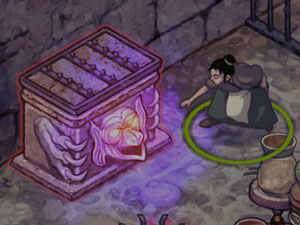
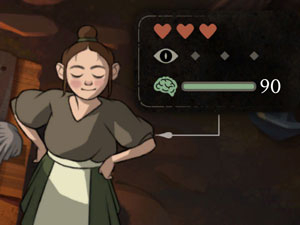
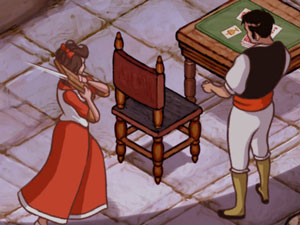 Read More
Read More
Featured Games
 Realm of Warriors
Assemble a party of the strongest heroes to take on both the rebel forces and the corrupting influence of the Dragon Demon in this Chinese-themed browser MMORPG, Realm of Warriors!
Realm of Warriors
Assemble a party of the strongest heroes to take on both the rebel forces and the corrupting influence of the Dragon Demon in this Chinese-themed browser MMORPG, Realm of Warriors!
 RAID: Shadow Legends
Recruit the best to join your team and take on Siroth, the Lord of Darkness himself!
RAID: Shadow Legends
Recruit the best to join your team and take on Siroth, the Lord of Darkness himself!
 Hustle Castle
Save the king and his daughter from the abyssal lord as he threatens to destroy your kingdom and marry your bride to be in this fun mmo simulation game.
Hustle Castle
Save the king and his daughter from the abyssal lord as he threatens to destroy your kingdom and marry your bride to be in this fun mmo simulation game.
 Dark Genesis
Play Dark Genesis and save the world from destruction with your allies.
Dark Genesis
Play Dark Genesis and save the world from destruction with your allies.
 War Robots
Head into the cockpit of a mech and decimate opponents in War Robots.
War Robots
Head into the cockpit of a mech and decimate opponents in War Robots.
 Blade of Kings
Blade of Kings is an idle RPG by Esprit Games. You’ll take a role of a warrior, defending the land from hordes of monsters and attempting to rise in rank in the kingdom. Take part in action-packed idle battles, use a variety of skills, raise pets, and achieve victory.
Blade of Kings
Blade of Kings is an idle RPG by Esprit Games. You’ll take a role of a warrior, defending the land from hordes of monsters and attempting to rise in rank in the kingdom. Take part in action-packed idle battles, use a variety of skills, raise pets, and achieve victory.






